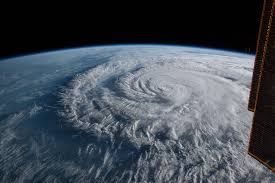By: Alyssa Lennon*
On the morning of September 14th, Hurricane Florence landed in North Carolina, wreaking havoc on the eastern coast of the United States despite having downgraded to a Category 1 storm by landfall[1].The storm decimated the southeastern United States, with unanticipated levels of flooding raising the estimated damages from $10 to $15 billion up to $17 to $22 billion[2].Unbeknownst to a significant portion of the American public due to the overwhelming news coverage of Hurricane Florence, southeastern Asia was also undergoing an intense, destructive storm surge. Typhoon Mangkhut was the strongest storm system on the globe in 2018 as of the present (11/6/2018), receiving a 10 (on a scale from 1- 10) on the Hong Kong Observatory’s storm scale with winds comparable to a Category 5 hurricane[3]. Both storms nearly coincided with the one-year anniversary of Hurricane Maria, which researchers at George Washington University now believe led, directly or indirectly, to the deaths of an estimated 2,658 to 3,290 Puerto Rican citizens in the 6 months following the storm[4]. In response to these alarming reports, US President Donald Trump vehemently denied the statistic, instead claiming that the number was developed and spread by political opponents in order to harm his reputation[5].
While Trump’s response to the estimated death toll may appear on the surface to be an outrageous response, it is consistent with his administration’s approach towards climate policies. According to climate researchers, the increase in destructiveness of major storms in recent years are partially a result of man-made climate changes. As in the case of Hurricane Florence, heightened sea levels off the coast of North Carolina (currently about foot higher than they were 100 years ago) drastically increased the region’s vulnerability to flooding during the storm[6]. However, despite these climate change impacts directly affecting those living within the United States, the administration has made clear that combatting the issue is not a priority. In 2017, the Trump administration announced its decision to pull out of the Paris Accord with the explanation that it did not reflect the best interests of the American people[7]. The United States’ decision to withdrawal from the Paris Agreement reflects current international sentiments regarding environmental policy, as increasingly evidenced in recent global conferences for the international agreement.
States convened in 2015 in an attempt to address and solve the issues of global warming and climate change collectively. The primary goal of this agreement, the Paris Accord, is to cap global warming at two degrees Celsius above pre-industrial temperatures[8]. Parties joined to the Paris Accord agree to participate in NDCs, or nationally-determined contributions, to lower their carbon emissions at the states’ own discretion[9]. While states are expected to regularly report their carbon emission statistics, it is crucial to note that the Paris Accord is an international agreement that does not challenge states’ sovereignty. States are left to their own discretion as to how drastic of changes they would like to enact in compliance with the agreement, or if they would even like to comply at all.
When the United States announced its decision to remove itself from the Paris Agreements, all funding previously committed to the organization could then no longer be reliably factored into budget considerations. Although the US Department of State still attends international conferences related to the Paris Agreement as no states are allowed to formally withdrawal until 2020, the lack of reliable funding from the international superpower has made the achievement of climate goals ever more difficult. Prior to the decision to withdraw, the United States had pledged $3 billion in aid money to Green Climate Fund (GCF), a primary financial resource of the United Nations Framework Convention on Climate Change (UNFCC), within which the Paris Accord was created and funded[10]. One of the financial goals of the Paris Accord was for developed states to collectively provide $100 billion in aid to the GCF by 2020 in order to provide a sufficient financial foundation for states’ policies, especially for the use of developing and poorer states[11]. With such a major international superpower pulling their financial backing, the goal, which was already unlikely given current contributions, is looking even more grim.
These shortcomings also reflect growing tensions between states within the Paris Agreement regarding the role of developed and developing nations. In addition to concerns regarding the developed states’ current contributions being insufficient towards the anticipated $100 billion that they are supposed to collect in only two years, developing states also voiced their concerns at a climate conference in Bangkok this month regarding the lack of transparency and regular statistics and projections in regards to finances[12]. As states involved with the Paris Agreement, especially developing states, are relying on such collective contributions in order to finance the necessary projects to achieve the goals of the Paris Accord, financial aid projections are necessary in order for states to design and adopt realistic and successful policies. However, developed states argued that such details as the documentation of funding reports are not necessary at this time and should be discussed further into international deliberations[13].
Core and periphery states have shown few signs of compromise on these crucial divisions. Perceptions of inequality still persist amongst developing states who feel that they are carrying the climatic burden of the Global North’s actions and are receiving unfair criticism in their inability to devote extensive resources, manpower, and attention to environmental issues due to their lower economic means. As previously discussed, one of the main facets of the Paris Agreement is its encouragement of all states to pursue the adoption of nationally-determined contributions in order to reduce world-wide carbon emissions. However, there is growing debate over whether developing and developed states should be required to meet the same expectations regarding NDCs. China especially is promoting the idea of differentiated NDC regulations between developed and developing nations in an attempt to limit the regulations that they would have to undergo in relation to the core economies[14]. These attempts at removing national responsibility also reflect the attempts made by developing states to alter the conventional definition of developing states within the Agreement to more accurately mirror current GDP’s. The Paris Accord currently uses 1992 definitions of developing and developed states, which has led 6 of the 10 wealthiest states to not be required to make contributions to the Paris Agreement despite their wealth relative to some of the required contributors[15]. The primary argument posed by states supporting economically differentiated NDC regulations is that such regulations are a form of neocolonial oppression preventing developing states from having the same opportunities for industrialization and economic expansion as the Global North.
Essentially, debate over the Paris Accord has become increasingly divided between developed and developing states, with both trying to redirect primary responsibility in enacting climate change policy away from themselves. These conflicts are becoming ever more alarming with the approach of autumn, marking less than three months until the start of the COP24 Conference in Poland. The conference, held in Katowice, will attempt to set in place the finer details and stipulations of the Paris Agreement, necessitating that states begin to come to agreements in the next few months regarding what the next steps in climate change policy need to be and establishing clear guidelines[16]. However, the outlook of recent international climate debates in conjunction with recent political developments, such as the United States’ decision to remove themselves from the agreement, leaves much cause for concern in proponents of environmental policy.
For the debate to stretch past the December deadline and the COP24 to fail to establish clear guidelines for climate change action of member states would be a major setback for the progress of environmental climate reversal in an increasingly affected world. The major storms of this past month have only been the tip of the iceberg of environmental changes around the world and the time left to reverse the man-made damage to the Earth is running thin. According to recent studies, unless international climate policies change rapidly within the next few years, the goals of the Paris Accord will not be met, and global temperatures will see an increase of 3.4 degrees Celsius by the start of the next century[17]. Additionally, the withdrawal of the United States from the Paris Agreement is particularly alarming as it is one of the states with the worst record of environmental sustainability. According to the EPA, the United States is the state with the second largest carbon footprint, preceded only by China[18]. With the United States’ withdrawal from the Paris Agreement, the potential to reduce this environmental damage and alter American thinking of climate change and environmental policy is significantly reduced.
Ultimately, it is crucial that states come to compromises within the next few months regarding how to distribute climate policy effectively and reasonably. While it is unrealistic to ask states to wholly set aside their interests for abstract and universal ideals, there needs to be an alteration in climate policy focus from political appeasement to the acknowledgement that, unless real changes are made, the Earth is entering a damaged state from which there is no return. Political and economic tolls as direct results of global warming are already occuring, with damages from Hurricane Florence projected to have a small but negative impact the United States national economy and devastating consequences on the local economy[19]. It is with great concern that we should look ahead in these next few months leading up to December and after, as the world watches to see if their political leaders will indeed hold their interests and the interests of future generations in mind.
- Brandon Miller, “Climate Change Is Making Storms Like Hurricane Florence Worse,” CNN, September 19, 2018, https://www.cnn.com/2018/09/19/us/climate-change-hurricane-florence-wxc/index.html.
- Patti Domm, “Hurricane Florence Damage Estimated at $17 Billion to $22 Billion and Could Grow Higher- Moody’s Analytics,” CNBC, September 17, 2018, https://www.cnbc.com/2018/09/17/moodys-hurricane-florence-damage-estimated-at-17-to-22-billion.html.
- Matthew Capucci, “Typhoon Mangkhut Was the Strongest Storm This Year. It Ravaged Hong Kong and the Phillipines,” The Washington Post, September 19, 2018, https://www.washingtonpost.com/weather/2018/09/19/typhoon-mangkhut-was-strongest-storm-this-year-it-ravaged-hong-kong-philippines/?noredirect=on&utm_term=.deb92159c0ee.
- Amy B. Wang, “Sorry Mr. President: The Hurricane Maria Death Toll Didn’t Grow by ‘Magic,’” The Washington Post, September 15, 2018, https://www.washingtonpost.com/politics/2018/09/15/sorry-mr-president-hurricane-maria-death-toll-puerto-rico-didnt-grow-by-magic/?utm_term=.9cd3577f16a8.
- Ibid.
- Miller, “Climate Change.”
- Frank Jordans, “Tackling Climate Change to Be Key Talking Point at UN Summit,” ABC News, https://abcnews.go.com/International/wireStory/tackling-climate-change-key-talking-point-summit-58023736.
- “The Paris Agreement,” United Nations Climate Change, https://unfccc.int/process-and-meetings/the-paris-agreement/the-paris-agreement.
- Ibid.
- Lesly Lotha, “Paris Agreement: Bangkok Conference Awakens Debate on Developed Nations’ Commitment,” Southeast Asia Globe, http://sea-globe.com/bangkok-conference-awakens-debate-on-developed-nations-commitment-to-paris-agreement/.
- Ibid.
- Jocelyn Timperley, “Bangkok Climate Talks: Key Outcomes on the Paris Agreement ‘Rulebook,’” Carbon Brief, https://www.carbonbrief.org/bangkok-climate-talks-key-outcomes-on-the-paris-agreement-rulebook.
- Lotha, “Paris Agreement.”
- Timperley, “Bangkok Climate Talks.”
- Telegraph Reporters, “What Is the Paris Agreement on Climate Change? Everything You Need to Know,” The Telegraph, https://www.telegraph.co.uk/business/0/paris-agreement-climate-change-everything-need-know/.
- “COP24 Will Be Paris 2.0,” United Nations Climate Change, https://unfccc.int/news/cop24-will-be-paris-20.
- Dana Nuccitelli, “New Study Reconciles a Dispute About How Fast Global Warming Will Happen,” The Guardian, September 24, 2018, https://www.theguardian.com/environment/climate-consensus-97-per-cent/2018/sep/24/new-study-reconciles-a-dispute-about-how-fast-global-warming-will-happen.
- “Global Greenhouse Gas Emissions Data,” United States Environmental Protection Agency, https://www.epa.gov/ghgemissions.
- Domm, “Hurricane Florence.”
*Disclaimer: The content contained in the following material is the sole ownership of the author and does not reflect the Towson University Journal of International Affairs nor Towson University in any respect whatsoever.







